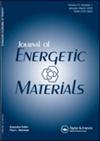Making progress towards promising energetic cellulosic microcrystals developed from alternative lignocellulosic biomasses
IF 1.9
3区 材料科学
Q3 CHEMISTRY, APPLIED
引用次数: 0
Abstract
ABSTRACT This study reported the valorization of various alternative lignocellulosic feedstocks including giant reed (GR), palm fronds (PF) and esparto grass (EG) for the development of promising nitrated structurally modified cellulosic biopolymers (NNCs). The extracted nanostructured cellulose precursors and their nitrated derivatives were analyzed for their physicochemical properties, chemical structure, crystallinity and thermal stability. Experimental findings confirmed the successful formation of the desired energetic NNCs polymers with increased densities (1.698–1.711 g/cm3) and high nitrogen contents (13.10–13.26%) followed the order NNC-EG>NNC-PF>NNC-GR, which are greater than those of the commonly used nitrocellulose (1.650–1.670 g/cm3 and 12.50–12.70%). Furthermore, isoconversional integral models (TAS, it-KAS and VYA/CE) were exploited based on non-isothermal DSC data to investigate their thermal decomposition kinetics. The predicted kinetic parameters displayed that the synthesized energy-rich NNCs presented close values of Arrhenius parameters within the range of 156 ≤ Eα (kJ/mol) ≤163 and 14.7 ≤ Log(A(s−1) ≤ 15.6, and decomposed following diverse reaction mechanisms. Consequently, the explored lignocellulosic biomasses could be considered as valuable alternative non-woody resources for the production of advanced high-energy dense cellulosic biopolymers for potential application in the next generation of solid propellant formulations and composite explosives.在利用替代木质纤维素生物质开发前景广阔的高能纤维素微晶方面取得进展
摘要 本研究报告了各种替代木质纤维素原料(包括大芦苇 (GR)、棕榈叶 (PF) 和esparto 草 (EG))的价值评估,以开发前景广阔的硝化结构改性纤维素生物聚合物 (NNC)。对提取的纳米结构纤维素前体及其硝化衍生物的理化性质、化学结构、结晶度和热稳定性进行了分析。实验结果证实,成功形成了所需的高能 NNCs 聚合物,其密度(1.698-1.711 g/cm3)和高含氮量(13.10-13.26%)依次为 NNC-EG>NNC-PF>NNC-GR,高于常用的硝化纤维素(1.650-1.670 g/cm3 和 12.50-12.70%)。此外,还根据非等温 DSC 数据利用等转换积分模型(TAS、it-KAS 和 VYA/CE)研究了它们的热分解动力学。预测的动力学参数显示,合成的富能量 NNC 在 156 ≤ Eα (kJ/mol) ≤163 和 14.7 ≤ Log(A(s-1) ≤ 15.6 的范围内呈现接近的阿伦尼乌斯参数值,并按照不同的反应机制进行分解。因此,所探索的木质纤维素生物质可被视为宝贵的替代性非木质资源,用于生产先进的高能量密度纤维素生物聚合物,有望应用于下一代固体推进剂配方和复合炸药。
本文章由计算机程序翻译,如有差异,请以英文原文为准。
求助全文
约1分钟内获得全文
求助全文
来源期刊

Journal of Energetic Materials
工程技术-材料科学:综合
CiteScore
5.70
自引率
4.80%
发文量
34
审稿时长
1.8 months
期刊介绍:
The Journal of Energetic Materials fills the need for an international forum of scientific and technical interchange in the disciplines of explosives, propellants, and pyrotechnics. It is a refereed publication which is published quarterly. Molecular orbital calculations, synthetic and analytical chemistry, formulation, ignition and detonation properties, thermal decomposition, hazards testing, biotechnology, and toxicological and environmental aspects of energetic materials production are appropriate subjects for articles submitted to the Journal.
 求助内容:
求助内容: 应助结果提醒方式:
应助结果提醒方式:


